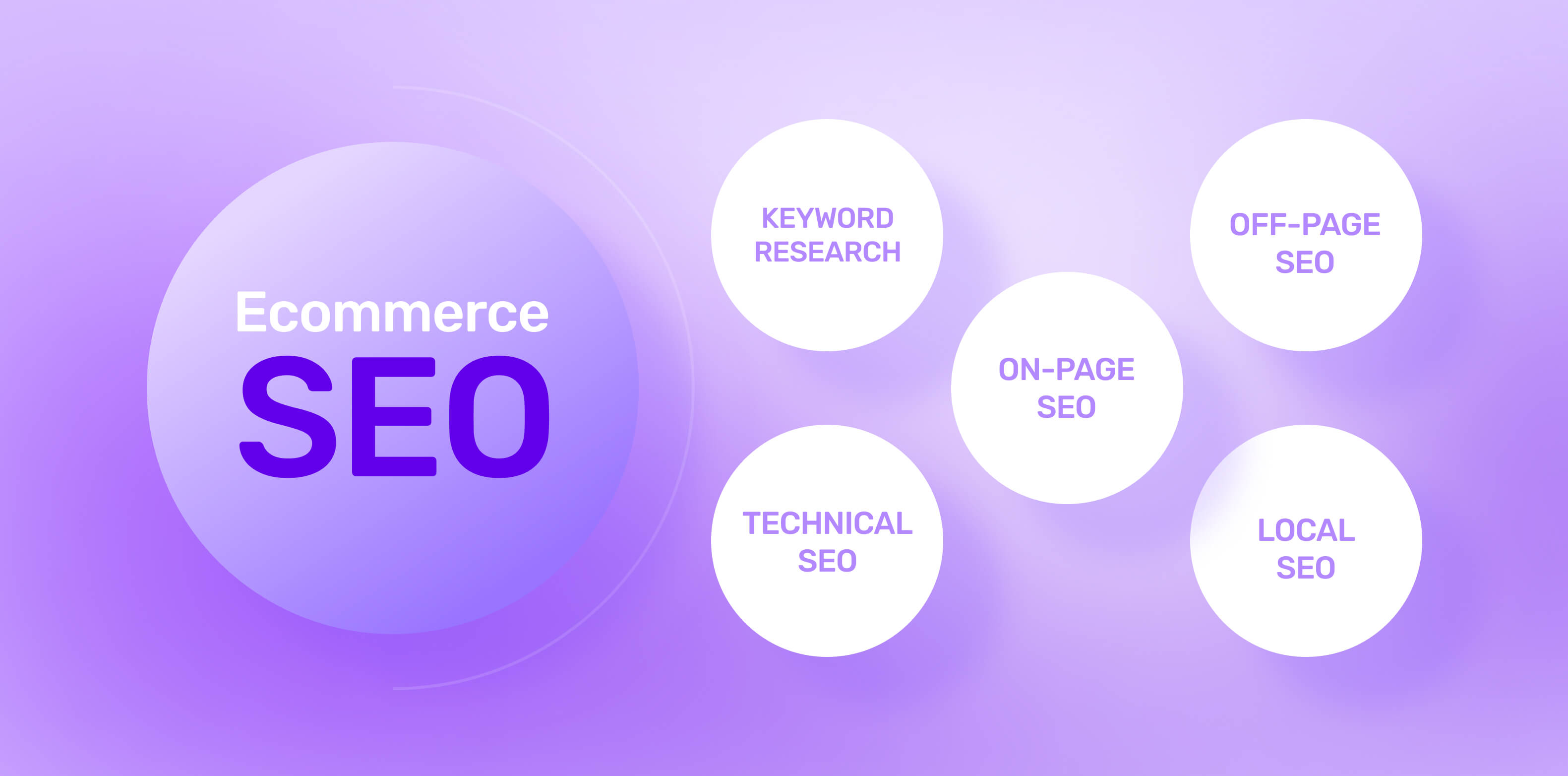Congratulations on building your ecommerce store. Now that your store is up and running, getting more traffic should be the top thing on your mind.
But how do you make sure that people find your store?
Enter ecommerce search engine optimisation (SEO).
Ecommerce SEO, helps you make adjustments to your ecommerce store so that it ranks on search engines, making it easier for customers to find your products.
For this guide, we reached out to many ecommerce SEO experts to find out how they optimise their product pages, the best practices they follow and what tools they use to execute it for their ecommerce platforms.
What is ecommerce SEO?
Ecommerce SEO is the practice of optimising online stores to improve their visibility and rankings on search engine results pages (SERPs). It involves doing keyword research, optimising content — both on and off pages — and doing technical enhancements.
By optimising your product pages to what search algorithms reward, like easy indexing, rich content, fast page loading times and credibility of your online store, you increase your chances of appearing higher and attracting organic traffic.
For instance, a home decor company can improve its SEO by creating content on “Best practices for creating relaxing interior spaces” and adding relevant keywords to its product pages.
Why does SEO matter for ecommerce businesses?

Today, 44% of online shoppers start shopping by using a search engine and 23.6% of all ecommerce orders are generated through organic traffic alone.
When a shopper uses search engines like Google and Bing to look for something, they're directed to the SERPs, where they'll find the most relevant results. Implementing ecommerce SEO techniques gives your product pages the best chance of ranking among the top 10 results.
Why is being in the top 10 important, you ask?
Because the top 10 results receive 94% of the clicks-through rates (CTR). In fact, the top ten results plus the sponsored results capture nearly all SERP clicks.
Ecommerce SEO is the best and only way to crack those high-prestige search result spots. We asked Diana Zheng, Head of Marketing for Stallion Express, about her results, who told us:
"Using our ecommerce SEO strategy, we’ve seen an impressive 40% increase in organic traffic and a 25% increase in conversion rates in the last year.”
How to conduct ecommerce SEO

Now that you know why ecommerce SEO is important, let’s dive into how you can do it for your online store. 👇
To execute ecommerce SEO, you need to work on 5 critical domains:
- Keyword research
- On-page SEO
- Technical SEO
- Off-page SEO
- Local SEO
Only when these 5 elements work together seamlessly can your online store have a strong foundation for ecommerce SEO, leading to maximum visibility and increased downloads.
1 - Perform ecommerce keyword research
Shoppers enter keywords and phrases into search engines to try and find what they’re looking for. Keywords are crucial because they bridge the gap between what your customer is looking for and the content on your ecommerce website or app.
On ecommerce keyword research, Shubham Singh, SEO at Demandsage.com explains:
“By conducting thorough ecommerce keyword research, identifying high-converting keywords and optimising product pages and category pages accordingly, I've been able to drive significant organic traffic and improve search engine rankings for ecommerce websites.”
Ryan Bemiller, an SEO specialist, explains how to find, choose and implement keywords ideas:
“For ecommerce websites, my keyword research looks like:
- Researching the primary niche(s) related to the product and niches related to the interests of the primary customers
- Deriving large lists of both long-tail and short-tail keywords, then refining those based on the site's current metrics, goals and competitors
- Grouping the chosen keywords into topic clusters, then grouping the related keywords for each desired article
- For each article that is to be written, define the primary keyword and its related keywords
- Separately list all target keywords that are related to product pages and category pages
- Research and write the articles and/or rewrite product page and category page descriptions.”
For your keyword research, you should always focus on keywords that are directly relevant to your products. For instance, if you sell organic skincare products, the relevant keywords you want to include could be “organic face cleanser”, “natural moisturiser”, “organic skin cream” or “organic beauty products”.
Other than short keywords, you should also include long-tail keywords to your product pages. For the above example, you can include the long tail keyword “best organic facial cleanser for sensitive skin”.
Finally, you should avoid keywords with extremely high difficulty levels as they may be too competitive to rank, especially when you’re just launching your store. Instead, you should aim for keywords with moderate difficulty and reasonable search volumes.
However, if you’re unsure how to balance keywords based on keyword difficulty and search volume, there are many keyword tools, free and paid, which we’ve mentioned below in this article. 👇
2 - Work on on-page SEO
On-page SEO involves optimising the elements directly on your ecommerce website to improve its search engine visibility. Elements such as title tags, meta descriptions, header tags and content optimisation all fall under on-page SEO.
For on-page content optimisation, Russell Davis, CEO, The Ecommerce Exec, says:
“Create topical, interesting and relevant content and become a trusted source for good content and authority.
“Work on EEAT (Experience, Expertise, Authority and Trust) at all times. This is because Google is going to rank you higher if you have something valuable, relevant to say and if you are an authority.”
Steve Pogson, Founder & Strategy lead at Helm Digital, says:
“For on-page optimisation, I make sure that each product page has unique, keyword-rich content that answers potential customers' queries.
“This includes using structured data to enhance product listings in search results, making it easier for search engines to crawl and understand the content and improving visibility.
“This focused approach has consistently elevated our product pages to the top positions in the search engine results for targeted keywords, significantly driving up organic traffic and sales conversions.”
David Rubie-Todd, Co-Founder and Marketing Director of stickerit.co, shares how he does on-page optimisation. He explains:
“First and foremost, we focus on optimising page titles and meta descriptions with relevant keywords and calls to action.
“We also ensure our product descriptions are unique, informative and engaging, rather than just copying and pasting manufacturer descriptions.
“Additionally, we pay attention to image optimisation by using descriptive file names and alt tags. We also include social sharing buttons on our product pages to encourage engagement and improve search visibility through social signals.
“Lastly, we regularly monitor and update our product pages with fresh content and user reviews.”
3 - Optimise off-page SEO
Off-page SEO involves optimising factors outside of your website to build its authority and reputation. Key techniques for this include link-building, content marketing, social media presence and online reputation management.
For link building, Julia Lozanov, Chief Editor at Verpex, says:
“In terms of link building, I employ a mix of outreach, guest posting and strategic partnerships to build high-quality, relevant backlinks that strengthen our domain authority and improve our visibility in search results.”
Other than link building, focus on cultivating a strong presence on social media platforms relevant to your business too, as social signals can indirectly influence SEO. Plus, you’ll also need to actively manage your online reputation by making sure that you respond to customer reviews and maintain a positive image online.
Other than link building, you should also work on creating relevant content. Paul Chow, CEO Design Dynamics, says:
“We love creating blog posts, FAQs and other helpful content. This way, people searching for information find us, learn a bit and hopefully see us as the go-to for their needs.”
4 - Improve technical SEO
Technical SEO focuses on the back-end aspects of your ecommerce website that impact its performance and accessibility to search engines. Prioritising technical SEO aspects ensures that search engines can easily understand and rank your ecommerce site, contributing to better visibility in search results.
As Cache Merrill, Founder of Zibtek, puts it:
“A strong foundation in technical SEO, including site speed optimisation and mobile responsiveness, ensures our ecommerce platform provides a seamless user experience.”
Mobile friendly design
On the importance of mobile optimisation for websites, Diana Zheng, Head of Marketing for Stallion Express, says:
“Like most marketers, I’ve made mistakes. One of our biggest mistakes wasn't optimising our website for mobile. As a result, we lost a lot of mobile traffic.
Fortunately, we learned our lesson and made sure to prioritise mobile responsiveness. In just a few months, we increased mobile conversions by 30%.”
Site speed
You need to prioritise website speed optimisation, as faster loading times improve the user experience and SEO rankings.
Russell Davis, CEO, The Ecommerce Exec, says:
“We make sure the page is marked up correctly and the page load speed is in the top 5% of sites in our vertical. We also work on reducing bounce rates, as this is a very good signal for search engines like Google and they don’t rank sites/pages highly if the bounce rate is high.”
A top tip shared by Kate Ross, SEO specialist at Irresistible Me:
“One learning experience was underestimating the importance of image optimisation, which slowed down our site. We resolved this by optimising images and saw improvements in speed and SEO.”
Site structure
Maintain an organised site architecture with user-friendly navigation that delivers a seamless user experience (UX). You should implement XML sitemaps to help search engines index your content efficiently.
Julia Lozanov, Chief Editor at Verpex, says:
“For technical SEO, I ensure our ecommerce sites are structured in a way that makes it easy for search engines to crawl and index our content.”
5 - Optimise your local SEO
If your business has a physical presence or serves a specific geographic area, prioritise local SEO efforts. You should start by optimising for local keywords that include location-based phrases, for example, “best pizza restaurant in [location]!” or “pizza near me”.
Search engines combine location signals from searchers with business results to deliver localised results. To achieve that Cache Merrill, founder of Zibtek, says he focuses on two aspects:
- Google My Business (GMB) optimisation - regularly update your GMB listings to ensure accuracy and completeness.
- Local keyword optimisation - incorporate location-based keywords into your content to capture local search traffic
Mimi Nguyen, Founder of Cafely, explains:
“In terms of local SEO, we make sure our business listings are accurate and consistent across all platforms, especially Google My Business (GMB).
We encourage our satisfied customers to leave positive reviews and ratings, which not only boosts our local credibility but also helps improve our rankings.”
Matt Little, Director & Owner of Festoon House, on how to optimise local SEO says:
“I prioritise consistency across online directories and listings, ensuring that my business name, address and phone number are accurate and consistent across platforms.
“This not only helps potential customers find my physical store but also enhances my credibility in local search results.
“Leveraging GMB effectively is also essential, as it allows me to showcase customer reviews, update business information and engage with local audiences directly.”
Want to build your online store?
Book a demoSpeak with one of our product experts today.
By proceeding you agree to Builder.ai’s privacy policy and terms and conditions

Ecommerce SEO best practises
Now that you know how you can conduct ecommerce SEO for your business, let’s take a look at some of the best practices you should follow.
As almost every SEO expert knows, SEO is rarely smooth sailing and you’ll learn by making a lot of mistakes along your way. Some of the best practices they’ve shared are 👇
1 - Add interactive elements to product pages
On using interactive elements on product pages to boost engagement, Kseniia Cherniaieva, the PR Manager for SEOProfy, says:
“On top of implementing SEO best practices, we've started integrating interactive elements to optimise our pages.
“These don't have to be anything complicated or lengthy. It can be as simple as short quizzes or survey tools that help our users choose products or services based on their unique preferences.
“We placed them on our product pages to increase the time spent on the page and found that they were also effective in lowering bounce rates.
“Improvements across these key performance metrics signal to search engines that our pages are high-value pages that are relevant to our target audience's searches, which helps us rank higher.”
2 - Focus on conversion
Steve Pogson, Founder & Strategy lead at Helm Digital, says:
“In implementing ecommerce SEO strategies, one of the key approaches I've prioritised is focusing deeply on conversion optimisation alongside traditional SEO metrics.
“A notable outcome from this dual-focus strategy was witnessed with a client's project, where we dramatically improved the conversion rate by 30% over a six-month period.
“This was achieved through rigorous A/B testing of product descriptions and images, ensuring they weren't only SEO-friendly but also compelling to potential customers.”
3 - Don’t over-optimise
Steve Pogson explains the dangers of over-optimising:
“One of my learning curves came from over-optimising pages for search engines at the expense of user experience. Initially, I heavily focused on keyword stuffing and density and neglected readability and user engagement.
“This mistake negatively impacted our dwell time and bounce rates. Learning from this, I shifted to creating more natural, engaging content that served the user first, which organically supported our SEO efforts, showing that balance is crucial in ecommerce SEO.”
4 - Use AI to implement local SEO strategies
Kseniia also explains how she uses artificial intelligence (AI) for Local SEO. She says:
“There are many SEO tools that specialise in local search optimisation that allow you to integrate AI so you can analyse large data sets to identify local search trends and customer behaviours specific to your area.
“You can use the insights these tools provide to refine your keyword strategy. Simply including "near me" and using local-specific terms in your website content, meta titles and service descriptions can make a big difference.”
Tools to use for ecommerce SEO
So, which tools should you be using to gain all these benefits? Here are some of the commonly used ecommerce SEO tools 👇
Google Analytics
Surendra Dhote, Technical SEO Manager at Builder.ai, says:
“Google Analytics (GA) is an indispensable tool in our arsenal. It streamlines our SEO initiatives and facilitates efficient tracking.
“Beyond SEO, we use GA for tracking sales and revenue, which are pivotal KPIs for assessing the tangible impact of SEO on our business.
“Additionally, GA helps us break down the sales funnel, helping us identify leaks in the user journey and address them.
“Its seamless integration and consistent performance across these critical areas underscore its significance, making it indispensable for our SEO success.”
Ahrefs
Steve Feiner, Managing Editor of Techjive, expresses his love for Ahrefs. He says:
“With good reason, Ahrefs is ranked highest on our list. The tool is excellent for researching keywords, analysing competitors, developing links and much more. With the help of this excellent ecommerce SEO tool, you can quickly and effectively carry out a thorough SEO audit of your online business.
Ahrefs is a wonderful tool for providing you with a full overview of where your ecommerce website ranks and where you still need to improve, from spotting broken links to determining where your posts rank.
It can also assist you in finding pages that link to your competitors alongside those that link to you and in doing an exhaustive backlink study.”
SEMrush
Mimi Nguyen, Founder of Cafely, says:
“For tools, we swear by platforms like SEMrush for keyword research, competitor analysis and tracking our SEO performance. It gives us invaluable insights into what's working and what needs improvement.”
Free SEO tools
And if you don’t fancy a premium SEO research tool, then good news – there are many no-cost options out there. Here are four you could try:
- Screaming Frog SEO Spider - crawls and analyses websites for SEO insights
- Ahrefs' Free Keyword Generator - generates keyword ideas for SEO
- Google Keyword Planner - provides keyword research analysis for Google Ad campaigns
- Smallseotools.com - offers a variety of free SEO tools like analysing website performance and optimising content
Conclusion
There’s no two ways about it: ecommerce SEO is vital to make it big on search results pages and achieve sales lift-off. By fine-tuning your product pages with smart strategies like keyword optimisation, technical enhancements and content improvements, you're not just boosting visibility on search engines, you're inviting more potential customers to discover what you offer.
As Diana Zheng puts it: “To sum up, ecommerce SEO strategy is all about strategic planning, learning from experience, following best practices and using the right tools to get the job done.”
If you want to learn more about ecommerce SEO and how it can help your online store, let’s get in touch with us 👇
Want to build your online store?
Book a demoSpeak with one of our product experts today.
By proceeding you agree to Builder.ai’s privacy policy and terms and conditions

Ananth Ramanathan runs Studio Store business at Builder.ai with a mission of digitising a 1M+ micro SMEs in the next 5 years. He oversees the commercial, product, and customer success functions to rapidly scale Studio Store globally. Ananth's an experienced tech business operator, a failed entrepreneur, and an active angel investor.













 Facebook
Facebook X
X LinkedIn
LinkedIn YouTube
YouTube Instagram
Instagram RSS
RSS


